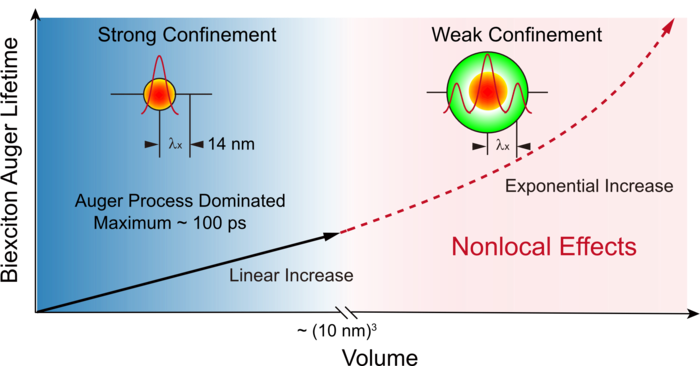Quantum dots (QDs) display excitonic capabilities with adjustable absorption and emission features for contemporary photonics as a result of the size-dependent quantum confinement effects. By integrating QDs and microcavities, effective single photon and entangled photon emission—key resources in quantum informatics—have been effectively demonstrated.
 Auger recombination lifetime linearly increases with volume in strong confinement regime (left), while exponentially increases in weak confinement regime (right) due to nonlocal effects. Image Credit: Peng Huang, Shipei Sun, Hairui Lei, Yongyou Zhang, Haiyan Qin, and Haizheng Zhong
Auger recombination lifetime linearly increases with volume in strong confinement regime (left), while exponentially increases in weak confinement regime (right) due to nonlocal effects. Image Credit: Peng Huang, Shipei Sun, Hairui Lei, Yongyou Zhang, Haiyan Qin, and Haizheng Zhong
In addition to epitaxially grown QDs, chemically produced colloidal QDs make excellent quantum emitters. Excellent single photon emitters were successfully shown in small CdSe and perovskite QDs (strong quantum confined), which exhibit substantial electron-electron coulomb repulsion.
Biexciton emission for colloidal QDs is often produced under high excitation intensity, which suffers from significant Auger recombination. In quantum-confined QDs, it has been discovered that the Auger recombination rate falls linearly with growing volume.
Researchers from the Beijing Institute of Technology’s Haizheng Zhong and Yongyou Zhang as well as Zhejiang University’s Haiyan Qin have uncovered nonlocal effects in large semiconductor nanocrystals in a new study that was published in the journal eLight.
They provide fresh approaches for producing multiple excitons with high efficiency for use in quantum optics and energy conservation applications.
Due to the reduced carrier density and momentum conservation, auger recombination in bulk materials barely influences biexciton recombination. To achieve high biexciton efficiency, thick-shelled CdSe/CdS nanocrystals were produced to limit Auger recombination.
By lessening the wave function overlap between the electrons and holes, the study team accomplished this.
Although they have not been extensively studied, large colloidal QDs may be ideal candidates for producing effective biexciton emissions. The study team found that the nonlocal effects could lead to an exponential drop in the Auger recombination rate in massive perovskite nanocrystals.
Nonlocal effects describe how wave spatial dispersion affects the interactions between light and matter. The optical response in metallic nanostructures has been satisfactorily explained by nonlocal effects in plasmonic.
The process by which one electron or hole absorbs an exciton to a higher energy level is known as auger recombination, which can also be defined as an energy transfer from one exciton to another electron or hole.
As a result, the exciton’s wavefunction plays a major role in determining the nonlocal effects of Auger recombination. Excitons in CsPbBr3 are estimated to have a wavelength of around 14 nm at ambient temperature, making it possible to witness nonlocal interaction-enhanced biexciton emission in large nanocrystals larger than 14 nm.
The study team saw remarkable biexciton efficiency in large CsPbBr3 nanocrystals, making use of the special defects tolerance capabilities of perovskite nanocrystals.
For small nanocrystals, there is a linear relationship between the volume and biexciton Auger recombination lifespan. The significant Auger recombination causes the maximal biexciton lifespan to be around 100 ps.
Auger recombination is mostly correlated with the carrier density and band structure for bulk materials with a constant coefficient. For instance, it is projected that a bulk crystal with a carrier density of 1018 will have a biexciton lifespan of 10 ns or less.
The nonlocal effects are predicted to cause the biexciton lifetime with volume in the mesoscale area to switch from linear scaling to exponential, which is what is initially seen in large CsPbBr3 nanocrystals.
After comparing their spectroscopic findings of large nanocrystals with those of previously reported small nanocrystals, the study team concluded that nonlocal effects of biexciton emission were present in CsPbBr3 nanocrystals.
Consider the nonlocal interactions between carriers and excitons during Auger recombination to illustrate such a nonlocal effect.
Large CsPbBr3 nanocrystals can attain high biexciton efficiency of up to 80% by progressively decreasing their Auger recombination rate as their volume increases.
Large nanocrystals have been shown to exhibit nonlocal effects, which can be used to produce enhanced quantum emitters with effective biexciton (multiple excitons) emission and open up new avenues for studying semiconductor nanocrystals beyond strong quantum confinement.
Journal Reference:
Huang, P., et al. (2023) Nonlocal interaction enhanced biexciton emission in large CsPbBr3 nanocrystals. eLight. doi:10.1186/s43593-023-00045-3.